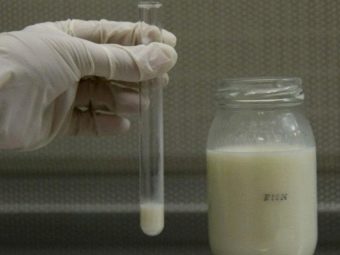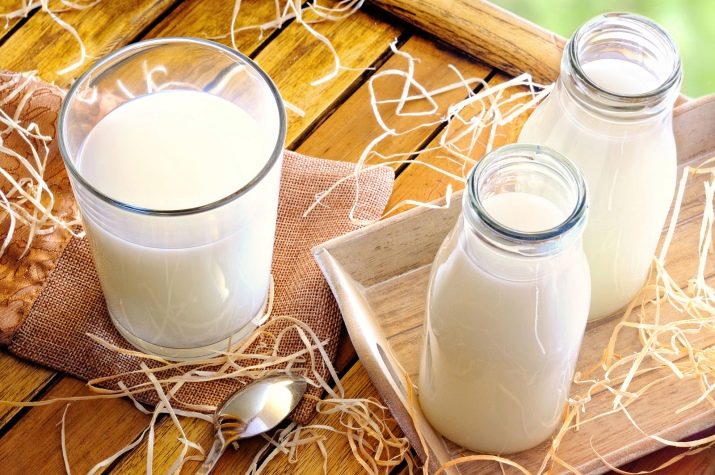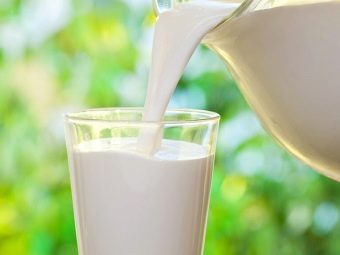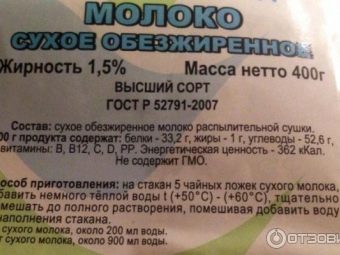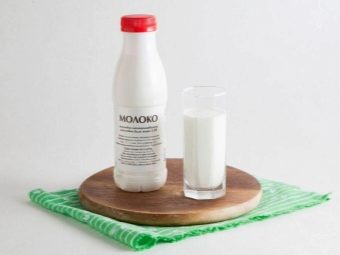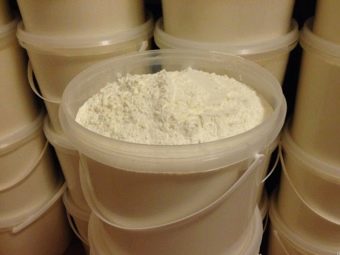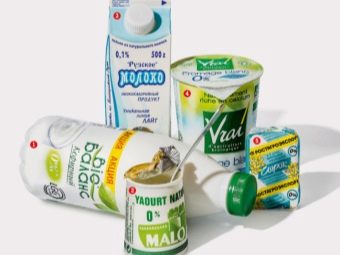Skimmed milk: nutritional value and calorie content, the pros and cons of drinking
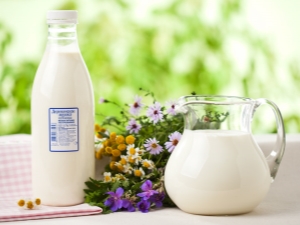
On the shelves of stores you can often see skim milk. It is not a novelty, since its production was established in Soviet times.To maintain a healthy lifestyle, an appropriate balanced diet has been developed. At the end of the twentieth century, the popularity of such milk decreased. However, in our time the situation has changed, as more and more people are paying attention not only to the quality of their food, but also to its composition.
What is it and how is it done?
If milk is separated from the milk in its original form (it is also called whole), then the result is its defatted component. In different literature, it may be called withdrawn or reversed. It has a light bluish tint, less viscous in consistency, with a higher density than that of the whole. Such a transformation becomes possible through the use of a separator. Previously, only major manufacturers had such devices. With the advent of more compact manual or electric models, even small peasant farms can produce low-fat dairy products. The process of normalization is followed by pasteurization, as a result of which all harmful bacteria die. This is necessary to ensure that the storage and consumption of the product is safe.
In the production process, you can get by with the usual items that are in every home. To do this, whole milk is poured into cans and placed in the refrigerator for a day. The resulting top layer, which is visible to the naked eye, is cream. They are removed with a spoon. On how carefully the cream was collected, will depend on the fat content of the product. As a rule, such milk can be called skimmed rather arbitrarily. It is more likely to be low fat (about 1.5%).
What is it used for:
- as a food product of humans or animals;
- as the basis for the production of certain types of dairy products;
- as an ingredient for pastry.
This product can be found not only in the form of a liquid, but also in the form of a dry powder. The content of nutrients is not inferior to liquid. To make it, pasteurized milk is thickened, homogenized and dried. In order to return it to the liquid form, you need only add chilled or hot water. It is also added to coffee or other beverages, widely used in cooking.
Composition
With apparent seeming simplicity, milk is a complex product. Most of it is water. Of the 100 grams, it takes 90. The rest is dry milk residue. In the skim condition, it weighs at least 9 grams. This indicator is considered one of the most important in determining quality. The smaller it is, the lower the quality (for example, when the resulting product is diluted with water).
Important ingredients are proteins (3 grams) and carbohydrates (4.8 grams). In these low-fat products allows a minimum fat content (up to 0.5 grams). The structure also includes:
- vitamins (A, D, B, C, H, PP, E);
- mineral substances (calcium, potassium, iron, manganese, sulfur, phosphorus, chlorine, fluorine, magnesium);
- organic acids;
- milk sugar (lactose).
Hundredths and thousandths are indicated the proportion of other vitamins and enzymes. All these components are in a certain natural balance, which allows them to be absorbed in the complex better than separately. The composition of the raw product includes microorganisms, which are also involved in enzymatic processes. In order to avoid reproduction of pathogenic microflora, it is better to pasteurize.
In addition to the beneficial substances in the composition may contain toxins, antibiotics, pesticides, detergents. Their content is strictly controlled. Harm from them can be only in the event that the maintenance and food of cows was wrong.
To be sure of quality, you need to choose a trusted manufacturer, where products are regularly monitored.
The energy value
Milk, like any other product that a person eats, is a source of energy.The amount of energy received by the human body after it is consumed depends on the content of such components as: proteins, fats, carbohydrates (BZHU) and organic acids. Energy value is measured:
- in kilojoules (denoted by kJ);
- in kilocalories (kcal). That is why you can still meet the term "calorie".
Calorie is an indicator that is indicated on the package. If there is no such data, you can make calculations yourself. With the oxidation of 1 gram of proteins, 4.1 kcal is released, 1 gram of carbohydrates - 3.7 kcal. For fats, this value is 2.3 kcal per 1 gram. However, their content in low-fat products is almost zero, so they are not counted. On average, the energy value per 100 grams of the product will be 31-35 kcal.
Low calorie will appeal to those who are accustomed to drink milk every day and do not know how to replace it. Tastes are almost identical to the whole product, and the caloric content is almost doubled.
It should be borne in mind that energy costs for women who are not involved in sports and lead a passive lifestyle, are 2000 calories per day (for men - 2500). The calorie content of just one cup of regular milk will be more than 120 kcal. 200 grams of skimmed milk give about 70 kcal. The obvious difference will help to make the right diet, which does not harm the body.
Dried milk is a kind of concentrate. Therefore, it contains more components and, accordingly, higher caloric content. This means that its use should be limited. Per day should be consumed no more than 100-150 grams.
Benefit
The question about the benefits of skimmed milk can be called debatable, because it is usually compared with a similar product, but the average fat content. So, let's look at its positive aspects:
- Even after normalization and pasteurization, most of the vitamins and trace elements are preserved in milk. They allow you to maintain the human body is normal.
- Low cholesterol will help avoid most cardiovascular diseases and keep the body normal for those who have already encountered these diseases.
- Low fat content contributes to the normalization and acceleration of metabolic substances in the body. Proper use of milk in conjunction with physical activity contributes to weight loss.
- This product is shown as a dietary, not only when gaining excess weight, but also for diseases of the digestive system. It can be used both in adult and in childhood.
- On its basis, manufacturers produce a whole line of dairy and dairy products. Here you can include vitamin-rich cocktails, juice milk drinks, yogurts, kefir, cottage cheese. For athletes, you can use options with a high content of protein.
Possible harm
The main problems arise when a person who is accustomed to drinking ordinary milk goes to skimmed milk. In this case, the body begins to receive less vitamins A, E, D, K. Their deficiency affects the immune system, eyesight, blood clotting, liver, thyroid and reproductive function. Vitamin D promotes the absorption of calcium, which keeps muscles and bones healthy. If for a long time a person has become accustomed to drinking high-fat dairy products, you need to think about how to fill the lack of fat-soluble vitamins.
With great care it should be treated to people with allergies to cow's milk protein. Of course, you can buy a goat. But in this case, the fat content will be quite large (about 1.5 percent). In this case, the protein is in fine form and is better absorbed. People with lactose deficiency can use a low-fat, low-fat product. But it must be tried with care.Moreover, with age fermentation can be broken, and even such a product can be used only with special preparations.
Medical consultation will be required for some diseases of the gastrointestinal tract.
Another issue is the presence of hormones and antibiotics in milk. It is believed that they are added directly to milk to increase the shelf life, injections are given to cows and added to them in feed In fact, the shelf life of a product is directly dependent on the degree of its pasteurization. And also on any large-scale production there is a laboratory in which the samples are thoroughly tested.
About what is better: fat milk or skimmed, see below.

